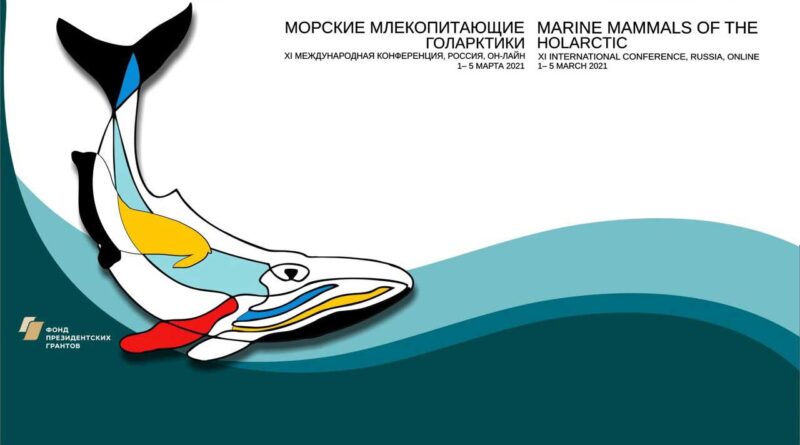Conservation Challenges for Land-locked Seals
On March 4-5, 2021, within the framework of the XI Marine Mammals of the Holarctic International Conference, Conservation Challenges for Landlocked Seals Session (CCLSS) was held. It was dedicated to the research of the Caspian seal, Ladoga and Baikal seal, gray and ringed seals inhabiting in the Baltic Sea.
Specialists from the Caspian states and other countries presented the results of their research on the biology and ecology of these species and subspecies, the demographic status of the populations, the impact of diseases and anthropogenic factors on the welfare of these seals. Scientists discussed the necessity to take measures for reduction of the marine mammal mortality during fishing, the importance of creating specially protected areas and water area and other priority issues for the preservation of these vulnerable animals.
The Caspian seal Pusa caspica (Gmelin, 1788), the only marine mammal inhabiting the Caspian Sea, plays a unique role in the Caspian ecosystem. Since November 2020, the species has been protected in all the Caspian countries. Crucial threats to the Caspian seal are the following: by-catch of seals in illegal fisheries, as well as the increase in illegal hunting on seals (deliberate catching with fishing gear for sturgeon and illegal killing), which is stimulated by increased market demand for seal fur and oil in the Caspian Region and other regions. Serious threats are considered to be habitat disturbance and destruction, diseases, including mass epizootics. Potential threats requiring attention are impacts of pollution (particularly persistent organic pollutants) on Caspian seals and their trophic chain, disruption to Caspian food-web due to overfishing, invasive species and habitat loss or modification for fish species; and global climate change causing loss of seals ice-breeding habitat and excessive heating of surface sea waters in summer.
The following reports on the studies of the Caspian seal were presented at the session:
- Rozhnov V.V., Solovjova M.A., Glazov D.M., Research of landlocked seals within the IEE RAS Program (abstracts Rozhnov et al., 2021).
- Baimukanova A.M. Study of the behavior of the Caspian seal (Pusa caspica) during spring haul-outs on the islands in Kendirli Bay and on the Durneva Islands in the Komsomolets Bay (abstracts Baimukanova, 2021).
- Shagilbayev A.U., Iskakov A.A., Baimukanov M.T. Atlas of otoliths of fish of the Caspian Sea – food objects of the Caspian seal Pusa caspica (abstracts Shagilbayev et al.,, 2021).
- Svolkinas L., Ermolin I., Suvorkov P., Holmes G., Goodman S.J. Quantitative assessment of seal mortalities in Caspian IUU fisheries and product quantities as a result of social networks illegally harvesting and trading in Caspian seal products (abstracts Svolkinas et al.,, 2021a).
- Ershova T.S., Zaitsev V.F., Chaplygin V.A. Features of the distribution of heavy metals in the body of the Caspian seal (Phoca caspica, Gmelin, 1788) (abstracts Ershova et al., 2021).
- Kydyrmanov A.I., Karamendin K.O., Kasymbekov Ye.B., Goodman S.J. Studying of the virome of Caspian seals Pusa caspica (abstracts Kydyrmanov et al., 2021).
- Kuznetsov V.V., Shipulin S.V. Assessment of ice breeding conditions of the Caspian seal population Phoca caspica (abstracts Kuznetsov, Shipulin , 2021).
- Lyushvin P.V., Buyanova M.O. Food reason of fluctuations of number of the Caspian seals (abstracts).
- Baimukanov M.T. Natural reserve for the conservation of the endangered Caspian seal Pusa caspica (abstracts Baimukanov, 2021).
- Svolkinas L., Ermolin I., Holmes G., Goodman S.J. Identifying consensus on conservation policy and incentives to disengage from illegal activity in an artisanal fishery with high rates of marine mammal bycatch and poaching (abstracts Svolkinas et al.,, 2021b).
(The Conference abstract book is available for downloading on Marine Mammal Council website).
CCLSS was organised by the Expert and Advisory Working Group for Caspian Seal Research and Conservation of IPEE RAS (Moscow, the Russian Federation) and the Caspian seal Ecology and Conservation Research Group of the University of Leeds (Leeds, UK), under the support of Marine Mammal Council, Theriological Society at the Russian Academy of Sciences.
The session was chaired by famous scientists: Academician of the RAS, Viatcheslav V. Rozhnov, Doctor of Biological Sciences, Chairman of Theriological Society at the Russian Academy of Sciences, Head of the RAS Permanent Expedition for the Study of Animals of the Red Data Book of the Russian Federation and Other Especially Important Animals of the Russian Fauna, Head of Kazakhstan-Russian International Caspian Seal Research Programme for the North Caspian,; Dr. Simon J. Goodman, Ph.D., Lecturer in Evolutionary Biology at the School of Biology of the University of Leeds, Lead for Global Conservation Strategy for the International Union for Conservation of Nature Pinniped Specialist Group.
The Press Secretary of the session was Nataliya R. Shumeyko, a Leading Engineer of the Laboratory for Behaviour and Behavioural Ecology of Mammals at IPEE RAS, Coordinator of Kazakhstan-Russian International Caspian Seal Research Programme for the North Caspian, Head of Kaspika Caspian Seals Conservation Agency.

